by Bùi Hoài Nam
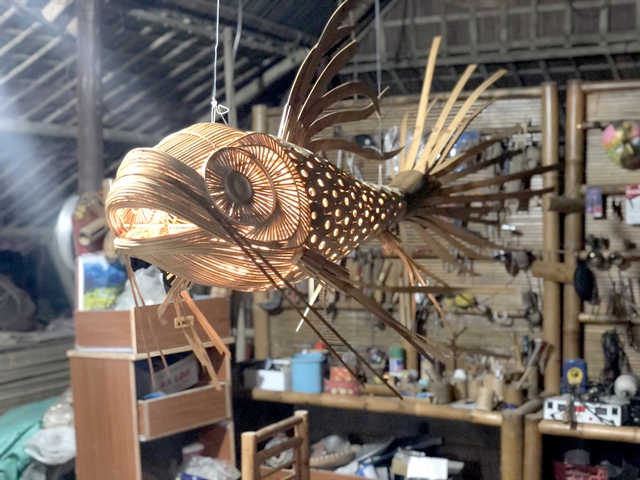
ON DISPLAY: A bamboo fish from the Taboo workshop, an innovative centre of the traditional craft. Photo courtesy of Taboo
Hội An local Võ Tấn Tân and his craftsmen created the Taboo Bamboo Workshop in the middle of the Cẩm Thanh nipa palm forest as a sustainable bamboo craft and preservation centre in the ancient town in central Việt Nam.
The workshop's skilled craftsmen make more than 200 unique traditional designs, from furniture and toys to household commodities and decorative items, under a low-carbon emissions model.
“This is the first sustainable, low-carbon production site in Hội An,” according to Tân. “We create products with our hands instead of relying on mass production via machinery. Our craftsmen design new models every single day.”
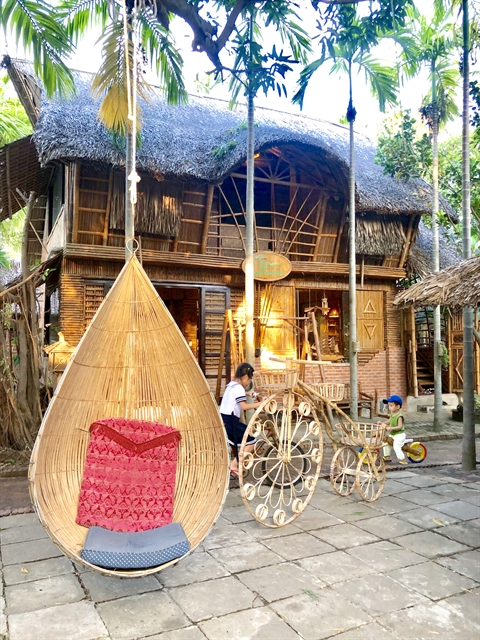
AT HOME: A bamboo house built by Taboo, which also offers craft tours. Photo courtesy of Taboo
“Our workshop doesn’t make replicas of the same items, instead creating unique products depicting the village and Hội An as unforgettable destinations. Our innovative designs and creations are all hand-made; we only use mechanical tools to smooth the finished products
Products from the Taboo workshop have been designed with recycling and environmentally-friendly consumption in mind, and Hội An has been promoting it as the first “zero” waste site in the country.
“Our craftsmen come up with innovative designs from bamboo, with products including cups, toys, lanterns, electric car bodies, bicycles, furniture, and interior décor,” Tân said. “Traditional production techniques have been passed down through the generations, and most villagers have some level of experience in making handicrafts from bamboo and nipa palm leaves.”
He was the first in Cẩm Thanh Village to create a bamboo bicycle and also built the first-ever bamboo electric car.
The bamboo craft has been his passion and he hopes to see Cẩm Thanh become greener and a popular, well-known destination for bamboo crafts.
Most pieces of bamboo can be used in production, by cutting and trimming the tubes as replacements for plastic, rubber, or steel components.
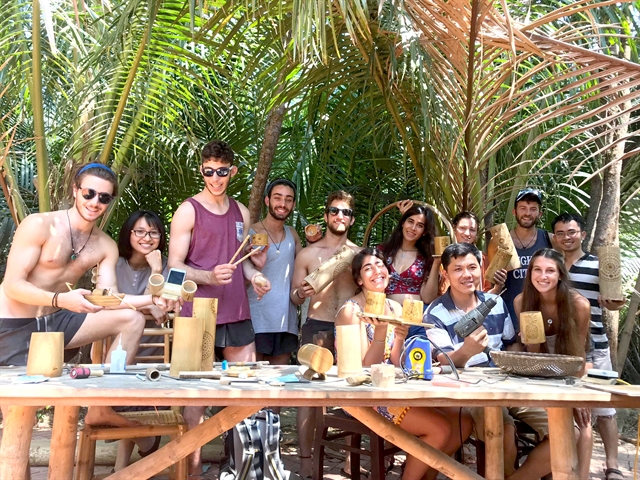
DAY TRIPPERS: Tourists trying their hand at the craft in Cẩm Thanh Village in Hội An, a popular eco-tourism site. Photo courtesy of Taboo
Nguyễn Xuân Trinh, 37, another local craftsman, said he left the trade a few years ago to provide transport services by coracle but eventually returned to Taboo.
“At least 1,000 coracles were built in the village as tourism boomed,” he said. “But tourism has now been hit by COVID-19, leaving thousands without work. Too many villagers poured money into making coracles for transporting tourists, turning the village into a noisy town rather than a tranquil rural community.”
Conflict began to be seen among coracle owners and travel agencies hoping to lower transport costs from VNĐ150,000 ($6.5) to VNĐ60,000 ($2.6) per trip.
“It all stemmed from poorly managed tourism services in the village, and thousands of coracle paddlers became unemployed when COVID-19 broke out,” he said. “I returned to work at the Taboo workshop, where I earn VNĐ350,000 ($15) a day. We still receive many orders for bamboo handicrafts and interior or garden décor items as well as lanterns and souvenir goods.”
Nguyễn Văn Tuấn, 42, also revived his craft skills after a few years providing coracle tour services.
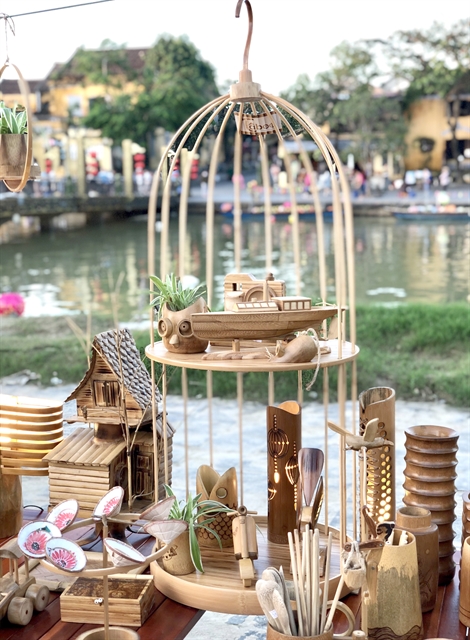
DELIGHTFUL DESIGNS: Bamboo handicrafts on display on the banks of the Hoài River in Hội An. Photo courtesy of Taboo
“I thought paddling a coracle and earning $10 for each 30-minute trip was easy money, but the pandemic had a terrible downside for tourism and a lot of people like me became unemployed,” he explained.
The craft helps villagers preserve their culture and lifestyle and earn a stable income. Hand-made products from the Taboo workshop, he said, which are mostly made under order, are priced five-times higher than mass-produced equivalents.
“The higher price of hand-made products is due to the innovation and skill of the craftsmen,” he said. “It’s an art form made by hand and from the heart. Every hand-made product is, by definition, unique.”
Effects of mass tourism
Phạm Biên, 65, is one of the oldest craftsmen in Cẩm Thanh and has been working with bamboo since it emerged as a main material for housing construction.
“Villagers used to build their houses from local bamboo and nipa palm leaves,” he said. “We also make coracles and interior décor items from nipa palm. Bamboo furniture from Cẩm Thanh became famous in terms of quality, and our bamboo souvenirs and household products are also a source of pride.”
Biên complained, however, that the boom in tourism over recent decades disturbed the economic structure in his tranquil village.
A lot of young local people looked down on traditional crafts and fishing, opting instead to provide coracle services or work as guides, which are much easier jobs.
“Conflict, unfair competition, and mass tourism services messed up local life,” he said. “Neighbours became bitter rivals, competing for tourists with homestay and boat services. The village was shaken by loud music coming from coracles, as boatmen danced for tips.”
Its tranquillity and scenery were unique attractions in Cẩm Thanh, and local lifestyles and culture had been preserved for generations. Concrete buildings now dot the village, he said, with property speculators seeking a quick profit from mass tourism.
COVID-19 then completely disrupted mass tourism and left at least a thousand coracle paddlers out of work.
“I hope that villagers keep working with handicrafts rather than relying on unstable mass tourism, which greatly affected local life and the economy,” he said. “The village was hosting 5,000 visitors a day two years ago, which was far too many and had negative consequences for all.”
“This is why I decided to preserve the local bamboo craft for the young generation. I hope it will play a role in making the village a ‘green’ and unique destination in Hội An.”
Local specialties
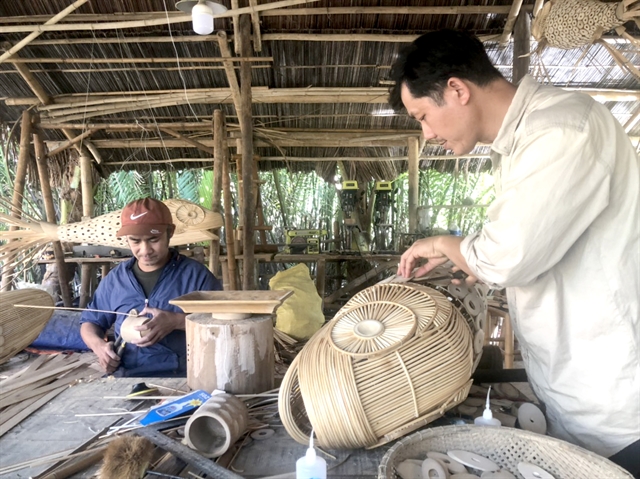
HANDY SKILL: Craftsmen in Cẩm Thanh Village making products from bamboo. The village has preserved the trade for generations. Photo courtesy of Taboo
Koi fish-shaped lanterns and reusable bamboo Christmas trees are among the latest designs to come from Taboo.
“Bird’s-nest rocking chairs are also a new innovation for garden décor and among the hundreds of unique designs we make from bamboo,” craftsman Trinh said.
Local craftsmen have also introduced a bamboo craft tour to the Taboo workshop, where visitors can hear more about the craft.
“Tourists can learn how to make their own bamboo souvenirs,” Tân explained. “We give them some help as they try their hand at making different items. They can choose what they want to make, and then take their own products home.”
According to the Việt Nam Chamber of Commerce and Industry, the country currently has more than 720 handicraft villages making bamboo products and over 1,000 bamboo and rattan production and trading companies, with annual exports standing at $250 million.
“Bamboo crafts have helped us live sustainably, and could revive the village as a centre of innovative bamboo creations,” Tân said. VNS
OVietnam